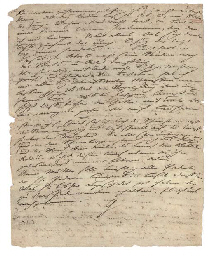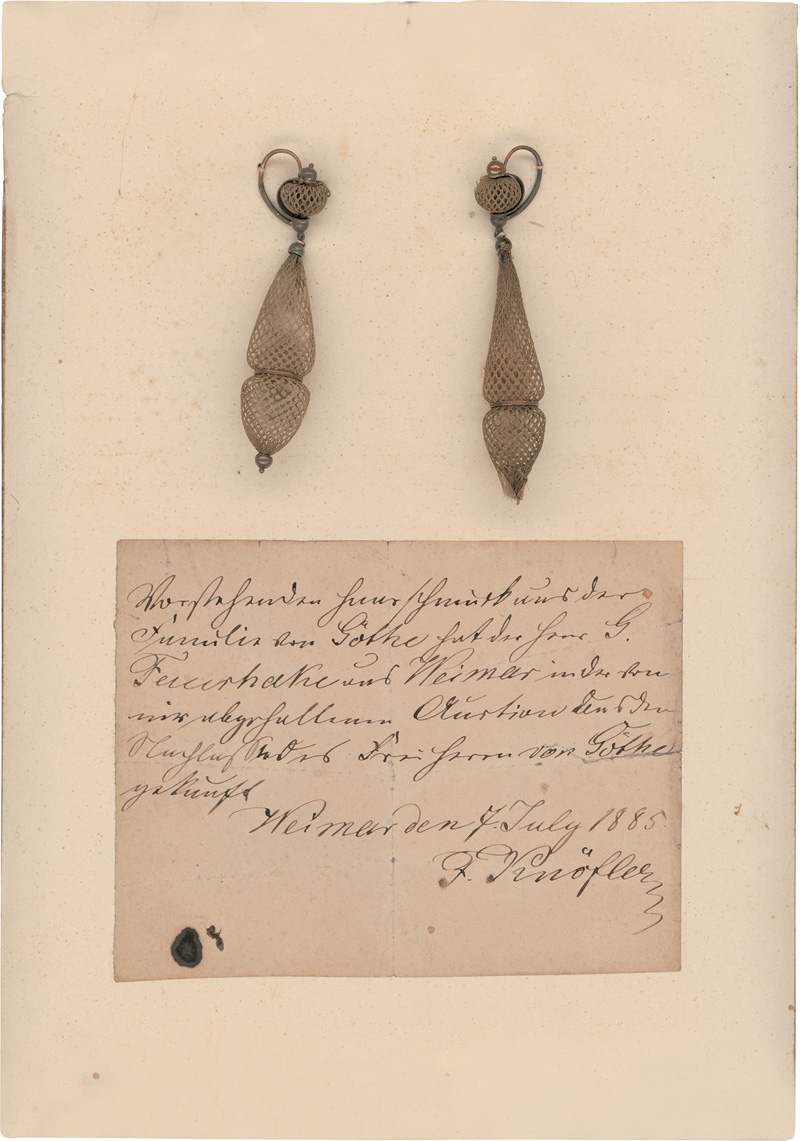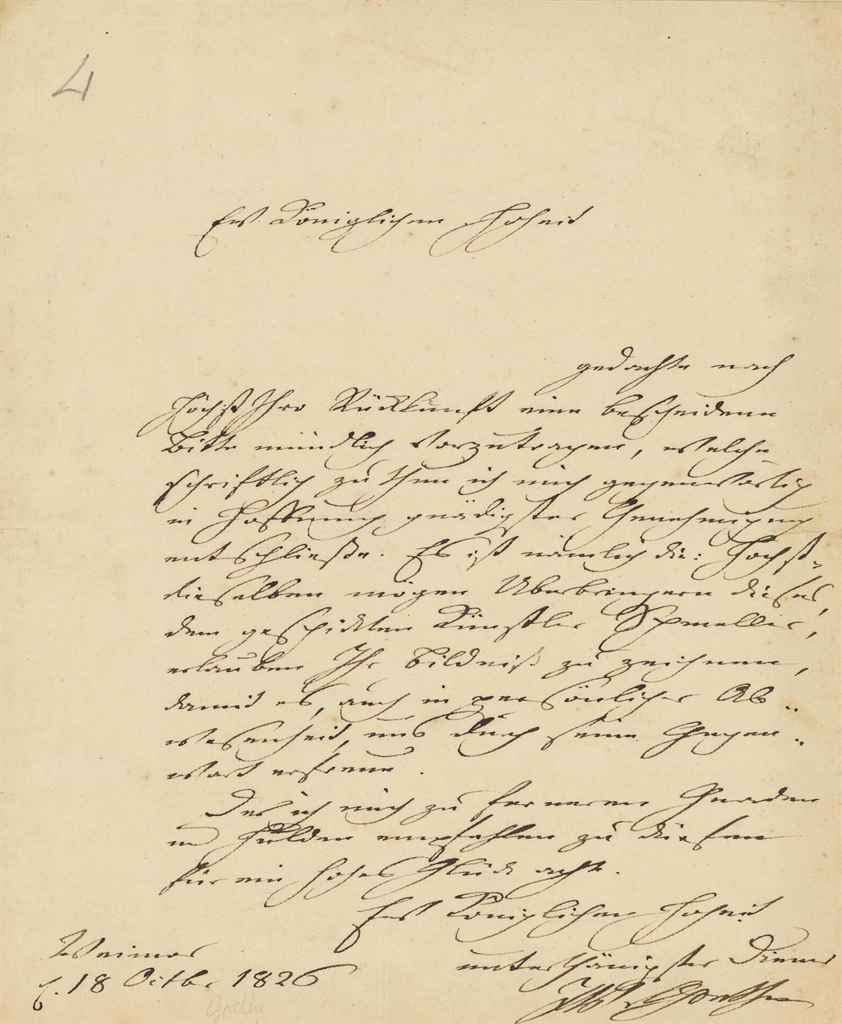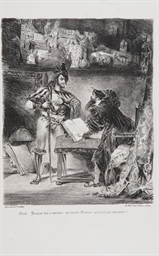GOETHE, Johann Wolfgang von (1749-1832). Large gold ring Goethe's, the oval glass gem engraved by Angelica Facius (1806-1887) depicting "Papirius and his mother." Ca. 1826. (19 x 15 mm). Provenance : Heinrich Lempertz (1816-1898), Goethe collector (his sale, "Goethe im Mittelpunkt seiner Zeit," J.M. Heberle [H. Lempertz Söhne] Cologne, 13 and 14 October, 1908, lot 657); purchased at this sale and by descent to the present owner.
GOETHE, Johann Wolfgang von (1749-1832). Large gold ring Goethe's, the oval glass gem engraved by Angelica Facius (1806-1887) depicting "Papirius and his mother." Ca. 1826. (19 x 15 mm). Provenance : Heinrich Lempertz (1816-1898), Goethe collector (his sale, "Goethe im Mittelpunkt seiner Zeit," J.M. Heberle [H. Lempertz Söhne] Cologne, 13 and 14 October, 1908, lot 657); purchased at this sale and by descent to the present owner. [ With :] GOETHE. Letter signed ("Goethe") to an unnamed recipient, dated Weimar 16 January 1826. Ink on heavy card. Goethe is inquiring if he can see Friedrich Wilhelm Facius' carnelian or chalcedony, or where he can obtain some. ("Man wünscht die kleinen Carneol oder Chalcedonsteine welche Herr Facius besitzt zu sehen oder zu erfahren wo dergleichen zu Ringen geeignet auswärts wohl zu haben wären.") (Mounted on card, some minor staining.) Provenance : Heinrich Lempertz (his sale lot 656, see above). A RING FROM THE LEMPERTZ GOETHE COLLECTION "...although single statues and larger groups of sculpture remain the foundation and the summit of all knowledge of art, yet, either as originals or as casts, they are seldom to be seen; on the contrary a little world of gems is made known, in which the more comprehensible merit of the ancients, their happy invention, judicious composition, tasteful treatment, are made more striking and intelligible, while, from the great number of them, comparison is much more possible" ( Truth and Fiction ). In Goethe's autobiography, Truth and Fiction ( Dichtung und Wahrheit ), he describes his interest in gemstones beginning as early as 1767. Goethe's diaries, letters and written work contain frequent references to gemstones as well as his personal collection, a testament to his life-long interest in the subject. In a letter from February 1832, written in the year of his death, to the famous German sculptor Christian A. Rauch, Goethe makes his last written reference to gemstones and mentions the engraver of the ring, Angelica Facius. Angelica Facius began her studies under her father, Weimar gem-engraver Friedrich Wilhelm Facius (1764-1843) and Goethe, who introduced her to Christian Daniel Rauch (1777-1857). She apprenticed in Rauch's studio between 1827 and 1834, and exhibited in 1830 and 1832 at the Berliner Academy Exhibitions. Facius worked on a number of commissions for the Weimar court including medals of Goethe, Schiller, and Grand Duchess Maria Pavlovna of Russia and Saxe-Weimar-Eisenach. The glass gem depicts "Papirius and his Mother" by Menelaos, but has also been identified as "friendship," "Merope and Aepytus," "Young Senator and his mother" and many other names. Until the beginning of the 19th century, the sculpture was in the Palazzo Ludovisi in Rome. Goethe visited the Palazzo several times during his Italian journey and visit to Rome in 1786-87. The ring later belonged to Heinrich Lempertz (1816-1898) one of the greatest Goethe collectors of all times. The motif on the ring was illustrated in his catalogue Goethe and his Time and described as "Philosopher and Student." The description states, that the stone was purchased by Friedrich Wilhelm Facius and cut by his daughter Angelika. The Lempertz Goethe collection was first documented in a catalogue in 1899. The monumental auction comprised 1460 lots. PERSONAL ARTIFACTS OF GOETHE ARE EXTREMELY RARE ON THE MARKET. Reference: Femmel/Heres Die Gemmen aus Goethes Sammlung. Leipzig, 1977 p.125; Goethe, Truth and Fiction Relating to My Life. New York, 1902 p.339; Haskell & Penny Taste and the Antique Yale University Press, 1998, p.288; Sammlung Lempertz Goethe im Mittelpunkt seiner Zeit Cologne, 1899 numbers 656 and 657; Thieme/Becker vol. XI p.181. (2)
GOETHE, Johann Wolfgang von (1749-1832). Large gold ring Goethe's, the oval glass gem engraved by Angelica Facius (1806-1887) depicting "Papirius and his mother." Ca. 1826. (19 x 15 mm). Provenance : Heinrich Lempertz (1816-1898), Goethe collector (his sale, "Goethe im Mittelpunkt seiner Zeit," J.M. Heberle [H. Lempertz Söhne] Cologne, 13 and 14 October, 1908, lot 657); purchased at this sale and by descent to the present owner.
GOETHE, Johann Wolfgang von (1749-1832). Large gold ring Goethe's, the oval glass gem engraved by Angelica Facius (1806-1887) depicting "Papirius and his mother." Ca. 1826. (19 x 15 mm). Provenance : Heinrich Lempertz (1816-1898), Goethe collector (his sale, "Goethe im Mittelpunkt seiner Zeit," J.M. Heberle [H. Lempertz Söhne] Cologne, 13 and 14 October, 1908, lot 657); purchased at this sale and by descent to the present owner. [ With :] GOETHE. Letter signed ("Goethe") to an unnamed recipient, dated Weimar 16 January 1826. Ink on heavy card. Goethe is inquiring if he can see Friedrich Wilhelm Facius' carnelian or chalcedony, or where he can obtain some. ("Man wünscht die kleinen Carneol oder Chalcedonsteine welche Herr Facius besitzt zu sehen oder zu erfahren wo dergleichen zu Ringen geeignet auswärts wohl zu haben wären.") (Mounted on card, some minor staining.) Provenance : Heinrich Lempertz (his sale lot 656, see above). A RING FROM THE LEMPERTZ GOETHE COLLECTION "...although single statues and larger groups of sculpture remain the foundation and the summit of all knowledge of art, yet, either as originals or as casts, they are seldom to be seen; on the contrary a little world of gems is made known, in which the more comprehensible merit of the ancients, their happy invention, judicious composition, tasteful treatment, are made more striking and intelligible, while, from the great number of them, comparison is much more possible" ( Truth and Fiction ). In Goethe's autobiography, Truth and Fiction ( Dichtung und Wahrheit ), he describes his interest in gemstones beginning as early as 1767. Goethe's diaries, letters and written work contain frequent references to gemstones as well as his personal collection, a testament to his life-long interest in the subject. In a letter from February 1832, written in the year of his death, to the famous German sculptor Christian A. Rauch, Goethe makes his last written reference to gemstones and mentions the engraver of the ring, Angelica Facius. Angelica Facius began her studies under her father, Weimar gem-engraver Friedrich Wilhelm Facius (1764-1843) and Goethe, who introduced her to Christian Daniel Rauch (1777-1857). She apprenticed in Rauch's studio between 1827 and 1834, and exhibited in 1830 and 1832 at the Berliner Academy Exhibitions. Facius worked on a number of commissions for the Weimar court including medals of Goethe, Schiller, and Grand Duchess Maria Pavlovna of Russia and Saxe-Weimar-Eisenach. The glass gem depicts "Papirius and his Mother" by Menelaos, but has also been identified as "friendship," "Merope and Aepytus," "Young Senator and his mother" and many other names. Until the beginning of the 19th century, the sculpture was in the Palazzo Ludovisi in Rome. Goethe visited the Palazzo several times during his Italian journey and visit to Rome in 1786-87. The ring later belonged to Heinrich Lempertz (1816-1898) one of the greatest Goethe collectors of all times. The motif on the ring was illustrated in his catalogue Goethe and his Time and described as "Philosopher and Student." The description states, that the stone was purchased by Friedrich Wilhelm Facius and cut by his daughter Angelika. The Lempertz Goethe collection was first documented in a catalogue in 1899. The monumental auction comprised 1460 lots. PERSONAL ARTIFACTS OF GOETHE ARE EXTREMELY RARE ON THE MARKET. Reference: Femmel/Heres Die Gemmen aus Goethes Sammlung. Leipzig, 1977 p.125; Goethe, Truth and Fiction Relating to My Life. New York, 1902 p.339; Haskell & Penny Taste and the Antique Yale University Press, 1998, p.288; Sammlung Lempertz Goethe im Mittelpunkt seiner Zeit Cologne, 1899 numbers 656 and 657; Thieme/Becker vol. XI p.181. (2)



.jpg?w=400)

.jpg?w=400)









Try LotSearch and its premium features for 7 days - without any costs!
Be notified automatically about new items in upcoming auctions.
Create an alert